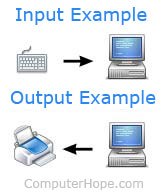IO
IO may refer to any of the following:

1. I/O (pronounced as eye-o) or input/output is any software or hardware device designed to send and receive data to and from a computer hardware component. For example, an NIC (network interface card) is an I/O device that interacts in this way with other network devices and computers. However, a computer mouse is only an input device, because it sends data but does not receive any. A monitor is an output device because it displays received information but normally doesn't send any data to its connected device(s), unless it's a touch screen.
With computer architecture, I/O is any device that sends information directly to and receives information from the CPU (central processing unit) and memory. For example, reading from a hard drive is considered I/O because the hard drive sends and receives information.
See our I/O device page for further information about I/O devices and a list of I/O devices.
2. When describing binary, IO (or 1 and 0) is an indication of on and off, the two states of the binary base-2 system.
3. With domain names, io or .io is a domain suffix for the British Indian Ocean Territory. The .io domains are used by tech companies and startups because of the related terms mentioned above.
4. With computer programming, Io is an object-oriented programming language created by Steve Dekorte in 2002. The language favors simplicity and flexibility over performance. Below is an example of printing hello world in Io.
"Hello, world!" println
5. When describing a file, io may refer to the io.sys file. For further information on this file, see: Information and help with the io.sys file.
Computer acronyms, Database terms, Hardware terms, Input, Input/output channel, Input/output supervisor, I/O device, I/O ports, Operating system terms, Output, Programming terms
